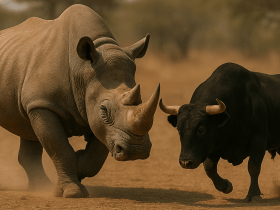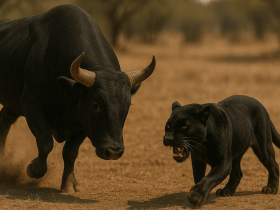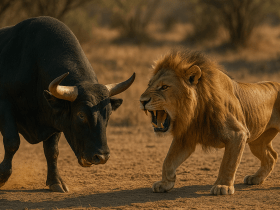In the edge of the forests very far away from each other two majestic animals live different lives. Sloth bear vs Cheetah ,One is build and designed for pure speed and hunting , The other one looks shaggy and slow. But still wild, strong and fearless. What if they meet each other? Will they fight? If fought who will win?
Cheetah (Acinonyx jubatus)
Sloth bear (scientific name: Melursus ursinus)
I always wonder can a cheetahs speed overcome the strength of a powerful opponent? With the below tables I have added all the details of these two legends with a scientific approach. So not only you can learn about these two animals But also you can decide who is the best design from the mother nature in the last!. So keep reading.
Hope you will enjoy!
1. Body Specifications
| Feature | Sloth Bear | ||
|---|---|---|---|
| Height (at shoulder) | 60–90 cm | 67–94 cm | Tie |
| Body Length | 1.4–1.9 m | 1.1–1.5 m | Sloth Bear |
| Weight | 55–145 kg | 21–72 kg | Sloth Bear |
| Muscle Mass % | High (~60%) | Moderate (~45%) | Sloth Bear |
| Bone Density | Very high | Moderate | Sloth Bear |
| Forelimb Strength | Powerful digging arms | Lean, flexible | Sloth Bear |
| Skull Strength | Thick & heavy | Streamlined | Sloth Bear |
| Neck Musculature | Strong | Moderate | Sloth Bear |
| Claw Length | 6–10 cm (non-retractable) | 3–4 cm (semi-retractable) | Sloth Bear |
| Canine Length | ~4 cm | ~2.5 cm | Sloth Bear |
Winner: Sloth Bear — Heavier, stronger build, more durable body.
2. Coat and Coloration – Sloth bear vs Cheetah
| Feature | Sloth Bear | Cheetah | Winner |
|---|---|---|---|
| Fur Color | Black shaggy coat | Golden yellow with black spots | Cheetah |
| Pattern | V-shaped chest mark | Distinctive black spots | Cheetah |
| Function | Camouflage + defense | Stealth and sun shield | Cheetah |
| Melanin Variants | Rare (melanistic) | Rare (king cheetah) | Tie |
| Shedding | Seasonal | Low | Cheetah |
| Fur Texture | Coarse | Smooth | Cheetah |
| Heat Retention | High | Low | Sloth Bear |
| Parasite Resistance | High | Moderate | Sloth Bear |
| Tail Markings | None | Black tufted tail | Cheetah |
| Facial Stripes | None | Tear-mark lines | Cheetah |
Winner: Cheetah — More efficient camouflage and fur adaptability.
3. Habitat and Range
| Feature | Sloth Bear | Cheetah | Winner |
|---|---|---|---|
| Native Range | Indian subcontinent | Sub-Saharan Africa, parts of Iran | Tie |
| Preferred Habitat | Dry forests, grasslands | Savannah, semi-desert | Tie |
| Elevation Tolerance | Up to 1,500 m | Up to 2,000 m | Cheetah |
| Climate Adaptability | High | Moderate | Sloth Bear |
| Territorial Range | 10–40 km² | 50–100 km² | Cheetah |
| Shelter Use | Dens, caves | Grass cover, termite mounds | Sloth Bear |
| Solitude Tolerance | High | High | Tie |
| Range Shrinkage | Severe | Severe | Tie |
| Adaptability to Disturbance | Moderate | Low | Sloth Bear |
| Proximity to Humans | Moderate | Low | Sloth Bear |
Winner: Tie — Both are regionally restricted but adapted to their niches.
️ 4. Diet and Feeding – Sloth bear vs Cheetah
| Feature | Sloth Bear | Cheetah | Winner |
|---|---|---|---|
| Diet Type | Insectivore/Omnivore | Carnivore | Tie |
| Main Food Source | Termites, honey, fruits | Gazelles, hares | Cheetah |
| Bite Force | ~400 PSI | ~475 PSI | Cheetah |
| Feeding Method | Sucking/snorting insects | Neck bite suffocation | Cheetah |
| Hunting Style | Foraging | High-speed chase | Cheetah |
| Digestive System | Omnivorous | Carnivorous | Tie |
| Prey Catch Success Rate | Not applicable | ~50% | Cheetah |
| Tool Use | None | None | Tie |
| Feeding Frequency | Daily | Every 2–4 days | Sloth Bear |
| Food Storage | None | None | Tie |
Winner: Cheetah — Efficient predator
5. Strength and Bite Force
| Feature | Sloth Bear | Cheetah | Winner |
|---|---|---|---|
| Bite Force (PSI) | ~400 PSI | ~475 PSI | Cheetah |
| Forelimb Power | Digging, striking | Light, flexible | Sloth Bear |
| Paw Swipe Force | High | Moderate | Sloth Bear |
| Muscle Density | High | Moderate | Sloth Bear |
| Neck Strength | Moderate | Strong | Cheetah |
| Claw Use in Fights | Primary | Minimal | Sloth Bear |
| Durability in Combat | High | Low | Sloth Bear |
| Skull Resistance | Strong | Thin | Sloth Bear |
| Fighting Endurance | High | Low | Sloth Bear |
| Jaw Opening Angle | Wide | Moderate | Sloth Bear |
Winner: Sloth Bear — Built for strength, endurance, and defense.
6. Speed and Agility – Sloth bear vs Cheetah
| Feature | Sloth Bear | Cheetah | Winner |
|---|---|---|---|
| Top Speed | ~40 km/h | 100–120 km/h | Cheetah |
| Acceleration (0–60 km/h) | ~5–6 s | ~3 s | Cheetah |
| Turning Agility | Low | Extremely high | Cheetah |
| Climbing Ability | Moderate | Low | Sloth Bear |
| Swimming Ability | Strong swimmer | Weak swimmer | Sloth Bear |
| Jumping Ability | Moderate | Can leap 6–9 m | Cheetah |
| Maneuverability | Low | Very high | Cheetah |
| Stamina | High (steady pace) | Low (sprints only) | Sloth Bear |
| Escape Reflex | Good | Excellent | Cheetah |
| Flexibility | Rigid body | Highly flexible spine | Cheetah |
Winner: Cheetah — The undisputed king of speed and agility.
️ 7. Senses – Sloth bear vs Cheetah
| Feature | Sloth Bear | Cheetah | Winner |
|---|---|---|---|
| Vision (Day) | Moderate | Excellent | Cheetah |
| Vision (Night) | Poor | Good | Cheetah |
| Olfactory Sense | Extremely strong | Moderate | Sloth Bear |
| Hearing Range | Good | Good | Tie |
| Whisker Sensitivity | Minimal | Moderate | Cheetah |
| Eye Adaptation | Limited | Specialized for daylight | Cheetah |
| Scent Tracking | Excellent | Fair | Sloth Bear |
| Sensory Integration | Moderate | High | Cheetah |
| Field of View | Narrow | Wide | Cheetah |
| Alertness to Movement | Moderate | High | Cheetah |
Winner: Cheetah — Sharper visual and sensory acuity for predation.
8. Reproduction and Lifespan
| Feature | Sloth Bear | Cheetah | Winner |
|---|---|---|---|
| Gestation Period | ~6–7 months | ~90–95 days | Cheetah |
| Litter Size | 1–3 cubs | 3–5 cubs | Cheetah |
| Weaning Age | 2–3 years | 6–8 months | Sloth Bear |
| Sexual Maturity | 3–5 years | 2–3 years | Cheetah |
| Lifespan (Wild) | 20–25 years | 10–12 years | Sloth Bear |
| Lifespan (Captivity) | Up to 30 years | Up to 17 years | Sloth Bear |
| Infant Mortality | Moderate | High (~90% die in the wild) | Sloth Bear |
| Parental Investment | High | Moderate | Sloth Bear |
| Reproductive Rate | Low | Moderate | Cheetah |
| Cub Defense | Aggressive mother | Relocates cubs often | Sloth Bear |
Winner: Sloth Bear — Longer life, better cub survival strategies.
9. Social Behavior – Sloth bear vs Cheetah
| Feature | Sloth Bear | Cheetah | Winner |
|---|---|---|---|
| Social Structure | Mostly solitary | Solitary or sibling groups | Tie |
| Mother-Cub Bond | Strong | Strong | Tie |
| Mating System | Promiscuous | Promiscuous | Tie |
| Territoriality | Low | Moderate | Cheetah |
| Communication | Snorts, grunts | Chirps, purrs, yowls | Cheetah |
| Conflict Avoidance | Low | High | Cheetah |
| Play Behavior | Moderate | High in cubs | Cheetah |
| Aggression Level | High | Low | Sloth Bear |
| Group Defense | Absent | Rare coalition defense | Tie |
| Tolerance of Humans | Moderate | Very low | Sloth Bear |
Winner: Tie — Unique solitary behaviors suited to different environments.
️ 10. Conservation Status
| Feature | Sloth Bear | Cheetah | Winner |
|---|---|---|---|
| IUCN Status | Vulnerable | Vulnerable | Tie |
| Global Population | ~20,000 | ~7,000 | Sloth Bear |
| Threats | Habitat loss, poaching | Habitat loss, inbreeding | Tie |
| Conservation Efforts | Moderate | Extensive (reintroductions) | Cheetah |
| Captive Breeding Success | Low | Moderate | Cheetah |
| Human-Wildlife Conflict | Moderate | High | Sloth Bear |
| Ecotourism Potential | Low | High | Cheetah |
| Protected Range % | ~30% | ~50% | Cheetah |
| Awareness & Funding | Low | High | Cheetah |
| Illegal Trade Impact | Moderate | High | Sloth Bear |
Winner: Cheetah — Though more threatened, it receives stronger conservation focus.
⚔️ Face-to-Face Fight Analysis: Sloth Bear vs Cheetah
⚡ The Confrontation Scenario
- Location: In a hypothetical savannah-meets-forest edge.
- Initiator: Unlikely — cheetahs avoid conflict, but a cornered one may strike.
Fight Breakdown
- Sloth Bear’s Strengths:
- Thick hide, long claws, high pain tolerance.
- Aggressive temperament and persistence in a fight.
- Cheetah’s Strengths:
- Agility, speed, and quick strikes.
- Exceptional reflexes and precision.
Combat Dynamics
When sloth bear fights with his strong grunts and with the attempts of grunts, cheetah is not capable of holding the attacks. It would be deadly for a cheetah , If he got a attack from the sloth bear. Even if it has the best speed he doesn’t have powerful forelimbs and stamina like sloth bear. One brutal swipe from a sloth bear is enough to make the cheetah fatal.
The thing is cheetahs are not designed for extended battles or heavy attacks.
Fight Winner: Sloth Bear — Too tough, too strong, too aggressive for the cheetah.
Final Verdict: Who Wins Overall?
| Category | Winner |
|---|---|
| Body Specifications | Sloth Bear |
| Coat and Coloration | Cheetah |
| Habitat and Range | Tie |
| Diet and Feeding | Cheetah |
| Strength & Bite Force | Sloth Bear |
| Speed & Agility | Cheetah |
| Senses | Cheetah |
| Reproduction & Lifespan | Sloth Bear |
| Social Behavior | Tie |
| Conservation Status | Cheetah |
Final Score:
Sloth Bear – 4 | Cheetah – 4 | Tie – 2
Overall Winner: Sloth Bear
✅ Why the Sloth Bear Wins:
- Greater physical abilities and brute strength.
- Aggressive nature and ability to stand ground.
- Can survive and defend itself against larger predators.
❌ Why the Cheetah Loses:
- Built for speed, not combat.
- Cannot withstand powerful physical attacks.
- Avoids fights, even with similarly sized animals.
In a real-world scene, the cheetah would run away. But if forced to fight, the sloth bear wins surely.
References (Short with Hyperlinks)
- IUCN Red List – Sloth Bear
- IUCN Red List – Cheetah
- National Geographic – Cheetahs
- WWF – Sloth Bear Profile
- BBC Earth – Cheetah Speed Secrets
Read More – Cheetah vs Crocodile – Who Wins? Best Scientific Comparison






Leave a Reply